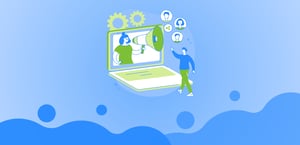
Top 10 FAQs about Customer Retention Going Into 2026
Why is customer retention becoming more critical than acquisition in 2026?
Customer acquisition costs have skyrocketed by 222% since 2013, with businesses now paying an average of $29 to acquire a new customer compared to just $9 a decade ago. Meanwhile, retaining existing customers is 5 times more cost-effective than acquiring new ones. More importantly, a mere 5% increase in customer retention rates can boost profits by 25-95%. As acquisition strategies become increasingly commoditized and competitive, retention has emerged as the true differentiator and moat for sustainable business growth going into 2026.
What are the average customer retention rates by industry in 2025-2026?
Customer retention benchmarks vary significantly across industries. Commercial insurance leads at 86%, followed by business consulting (85%) and IT & managed services (83%). The banking sector maintains a solid 75% retention rate, while telecom holds at 78%. Mid-tier performers include B2B services (76-81%) and retail (63%), though retail continues to decline. The hospitality and travel sector struggles most, with only 55% retention due to price sensitivity and fluctuating customer expectations. Understanding your industry benchmark is essential for setting realistic customer retention goals and measuring performance.
How does customer lifetime value relate to retention strategies in 2026?
Customer lifetime value (CLV) is directly tied to retention success. Repeat customers spend 67-70% more than first-time buyers, and the probability of selling to an existing customer is 60-70% versus only 5-20% for new prospects. Most significantly, 80% of a company's future revenue is projected to come from just 20% of existing customers. Marketers in 2026 must focus on high-value customer retention strategies that maximize CLV through personalized engagement, proactive support, and ongoing value demonstration rather than one-time transactional relationships.
What role does AI and predictive analytics play in customer retention for 2026?
AI-powered customer retention strategies are becoming essential for identifying at-risk customers before they churn. Predictive analytics helps marketers analyze behavior patterns, purchase frequency, and engagement signals to anticipate when customers are likely to disengage. Smart retention systems can automatically trigger re-engagement campaigns for customers who haven't interacted in 30 days, send replenishment reminders based on consumption patterns, and identify high-value shoppers showing declining activity. AI-driven personalization is enabling hyper-relevant experiences that keep customers engaged without overwhelming them with generic messaging.
How important is omnichannel customer experience for retention in 2026?
Omnichannel consistency is non-negotiable for customer retention success. 75% of customers expect consistent experiences across all channels (online, in-store, mobile), and inconsistency leads directly to dissatisfaction and higher churn rates. Companies with the strongest omnichannel customer engagement strategies achieve 10% year-over-year growth, 10% increases in average order value, and 25% higher close rates. Marketers must ensure seamless support across every platform where customers interact with their brand, unifying data and communications to deliver cohesive experiences that drive long-term customer loyalty.
What makes loyalty programs effective for customer retention in 2026?
Modern loyalty programs in 2026 go far beyond traditional points-and-prizes models. Effective programs are data-driven, offering personalized rewards based on purchase history, behavior, and preferences. Businesses implementing customer loyalty programs see a 5% increase in retention rates, and 79% of Millennials stick with brands offering valuable loyalty programs. The most successful programs incorporate gamification (increasing engagement by 47%), experiential rewards rather than just discounts, and premium membership tiers that provide immediate tangible benefits. The key is creating programs that feel personal and relevant rather than transactional.
How do poor customer experiences impact retention rates in 2026?
The cost of poor customer service is devastating to retention efforts. 96% of customers will leave a brand after experiencing poor service, and 33% will switch to a competitor after just one negative experience. It takes 12 positive experiences to compensate for a single negative one, making prevention absolutely critical. Conversely, 89% of customers who have positive service experiences are likely to return, and 73% cite customer service quality as significantly influencing their loyalty decision. Investing in exceptional customer support and proactive issue resolution is essential for reducing customer churn and maintaining healthy retention rates.
What are the biggest customer retention challenges facing businesses in 2025-2026?
U.S. companies lose an estimated $168 billion annually due to customer attrition. The biggest challenges include lack of personalized engagement (25% of customers leave due to insufficient personalization), poor communication about product value (38% of customers don't fully understand benefits), and unmet expectations (19% cite delivery not matching promises). Additionally, 44% of companies still focus more on acquisition than retention, missing significant profitability opportunities. Rising competition, price sensitivity, and evolving consumer behaviors create ongoing pressure, especially in retail and hospitality sectors experiencing declining customer retention rates.
How can marketers measure customer retention success effectively?
Marketers should track five core customer retention metrics: Customer Retention Rate (CRR) measures the percentage of customers retained over a period; Customer Churn Rate shows how many customers discontinue during a timeframe; Customer Lifetime Value (CLV) quantifies total revenue contribution throughout the relationship; Net Promoter Score (NPS) gauges willingness to recommend; and Repeat Customer Rate tracks multiple purchases. Additionally, monitor Purchase Frequency Rate and Customer Satisfaction Score (CSAT). These KPIs provide comprehensive insights into retention health and help identify which customer retention tactics are driving the strongest results.
What customer retention strategies will be most effective in 2026?
The most effective customer retention strategies for 2026 combine technology with human-centered approaches. Prioritize personalized cross-channel experiences using unified customer data, implement AI-powered predictive retention to catch churn signals early, and leverage omnichannel support for seamless interactions. Build emotional connections through educational content marketing (53% of customers stay loyal to brands providing useful content) and user-generated content sharing. Deploy smart loyalty programs with gamification and experiential rewards, not just discounts. Finally, focus on excellent onboarding, proactive customer success programs, and continuous feedback implementation—businesses acting on customer feedback see 10% retention increases.



